ISSN Online: 2177-1235 | ISSN Print: 1983-5175
Augmentation brachioplasty: surgery for improving the appearance of the arms
Braquioplastia de aumento: cirurgia para rejuvenescimento dos braços
Original Article -
Year2012 -
Volume27 -
Issue
1
Ivan Abadesso1; Fernando Serra2
ABSTRACT
BACKGROUND: Silicone implants are used in several regions of the body. In women, sagging of the triceps muscle is a major concern. Meanwhile, men consider biceps and triceps hypertrophy to be a symbol of masculinity and beauty. Here, we describe a relatively simple and reproducible procedure used for esthetic purposes to increase arm circumference or correct mild to moderately sagging skin using gel silicone implants and elastomer.
METHODS: Thirty-two patients were selected and operated on. Two to four implants per arm were introduced.
RESULTS: The esthetics of the arms improved significantly in the studied patients, with a satisfaction rate exceeding 90%. The procedure improved static evaluation and arm movement, which were the major complaints of majority of the female patients.
CONCLUSIONS: The surgical technique presented for augmentation brachioplasty is safe and reproducible, and should be considered by plastic surgeons in an attempt to achieve better results with smaller incisions.
Keywords:
Arm/surgery. Silicone gels. Silicone elastomers. Prostheses and implants.
RESUMO
INTRODUÇÃO: Os implantes de silicone são utilizados em diversas regiões do corpo. Em mulheres, a flacidez da musculatura do tríceps constitui um dos grandes incômodos; por outro lado, em homens, a hipertrofia da região do bíceps e tríceps é sinal de masculinidade e beleza. O objetivo deste trabalho é descrever uma técnica relativamente simples e reprodutível para aumento da circunferência do braço ou para correção de flacidez de grau leve a moderado com fins estéticos, com uso de implantes de silicone gel e elastômero.
MÉTODO: Foram selecionados e operados 32 pacientes, com a introdução de no mínimo 2 implantes e no máximo 4 implantes por braço.
RESULTADOS: Houve melhora significativa da estética dos braços dos pacientes estudados, com índice de satisfação superior a 90%. A melhora foi sentida na avaliação estática e em movimento do braço, grande queixa da maioria de pacientes do sexo feminino.
CONCLUSÕES: A técnica cirúrgica apresentada para braquioplastia de aumento é segura e reprodutível, sendo mais uma opção no arsenal terapêutico do cirurgião plástico em sua busca por resultados melhores, com incisões menores.
Palavras-chave:
Braço/cirurgia. Géis de silicone. Elastômeros de silicone. Próteses e implantes.
INTRODUCTION
Sagging brachial-shaped deformities are a major concern among women and a challenge for plastic surgeons as the extension of scars limits the indications for brachial lift and reduces patient acceptance. However, men consider brachial hypertrophy masculine and attractive; many find it difficult to achieve brachial hypertrophy because of the commitment of regular physical exercise and controlled diet.
The sharp increase in plastic surgery in the last few decades presumably reflects easy access to information through different media, particularly the internet, through which data such as costs and risks can easily be found1. Commercially available implants have been used differently to enhance body shape. Bartels et al.2 used breast implants for gluteal reconstruction in 1969, whereas Saray et al.3 placed calf implants to correct shoulder deformities. Calf implants have been used for arm augmentation4, mainly reconstruction, using a different procedure from that presented in this work.
Implants have been used in male patients in the past 20 years1,3-7. The idea of placing implants in the arm arose to fulfill male patient' request to increase brachial muscle volume. The use of breast implants5-7 in the arms (i.e., biceps and triceps) makes volumetric augmentation with alloplastic materials challenging, which is necessary to harmonize the body shape of these patients.
The purpose of this study is to describe a relatively simple and reproducible esthetic procedure to increase arm circumference or correct mild to moderate sagging skin using gel silicone implants and elastomer.
METHODS
Augmentation brachioplasty was performed in 32 patients (18 males and 14 females; range, 23-73 years; mean, 30.5 years) from November 2006 to December 2010.
The main aim of this surgery was to increase brachial volume in 16 patients (50%), correct sagging skin in 9 (28.1%), improve appearance after bariatric surgery in 5 (15.6%), and repair in 2 (6.3%).
All patients read and signed an informed consent form. This study was conducted in accordance with the bioethics guidelines of the Helsinki Declaration and its revisions.
Surgical procedure
Silicone gel implants and elastomer were assembled (Figure 1) and placed within the submuscular region of the biceps and triceps. The procedure was carried out under general anesthesia in 75% of cases and local anesthesia with sedation in the remaining 25%.
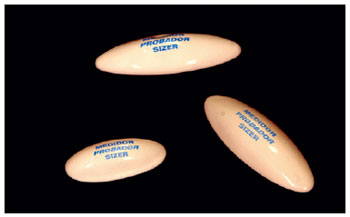
Figure 1 - Implant templates.
With the patient in the supine position with arms abducted, the intermuscular septum was identified in the middle of the arm (Figure 2) and a 4-cm-long S-shaped mark was placed where the incision was to be made (Figure 3). Xylocaine solution (0.25%) and 1:160,000 adrenaline were infiltrated in the dissection area in order to access the anterior and posterior regions. A supraperiosteal digital detachment was performed without muscle detachment through the opening of the medial intermuscular septum, followed by confection of the submuscular region for implant introduction (Figure 4). The neurovascular bundle was identified and was allowed to remain intact (Figure 5).

Figure 2 - Palpation of the intermuscular septum.
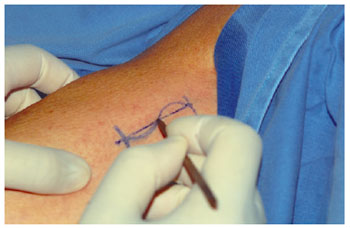
Figure 3 - S-shaped incision mark.

Figure 4 - Confection of the submuscular region.
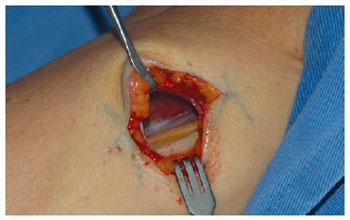
Figure 5 - Neurovascular bundle.
Implant preparation
To increase the volume of the biceps and triceps, 1 or 2 calf implants per muscle group was used (Silimed®, Brazil); therefore, 1-4 implants per arm were used.
To obtain more volume and a more natural look, silicone elastomer calf implants were assembled with cohesive gel silicone implants (Figure 6). To facilitate their simultaneous introduction, the implants were joined by 3.0 nylon string through sutures in the elastomer and were held together with 5-mm-thick silicone tape (Figures 7 and 8).
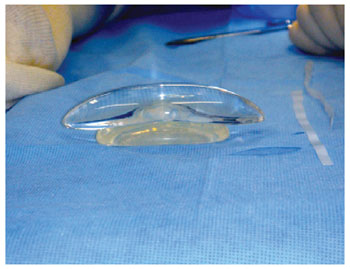
Figure 6 - Gel implant and elastomer assembly.

Figure 7 - Suture in the implant elastomer.
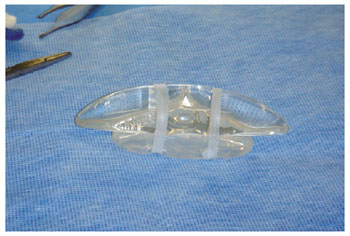
Figure 8 - Gel implants and elastomer bound with silicone tape.
The implants were then introduced in the previously dissected submuscular region (Figure 9), and suturing in 3 surgical planes was performed.
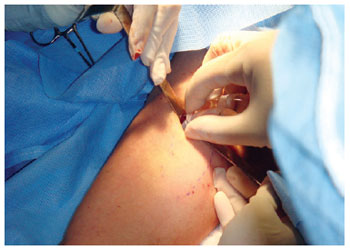
Figure 9 - Introduction of the implants in the muscular region.
Non-steroidal anti-inflammatory drugs and common analgesics were administered during the postoperative recovery period.
Patients remained in a relative resting state for 5 days without exerting their arms. Physical activity was allowed 45 days after surgery.
RESULTS
In the first 2 patients, only 1 silicone gel implant was used; the results indicated that a second associated implant was necessary to achieve a better outcome.
The remaining patients of both sexes received 2 implants per muscle group, resulting in a total of 8 implants per patient.
The esthetics of the arms of the patients improved significantly, with a satisfaction rate exceeding 90%. Both static evaluation and arm movement improved, which were the major complaints of majority of the female patients.
Figures 10 and 11 illustrate the results obtained for treatment of sagging skin and brachial volume augmentation in 2 patients.

Figure 10 - In
A and
B, preoperative images. In
C and
D, 6-month postoperative images. In
E and
F, 3-year postoperative images.
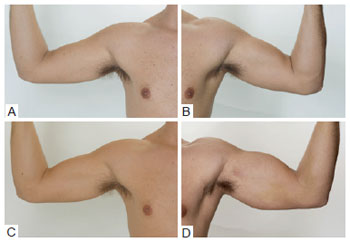
Figure 11 - In
A and
B, preoperative images. In
C and
D, 18-month postoperative images.
Persistent pain was reported by 1 man and 1 woman (6.25%). The woman also presented with paresthesia and decreased muscle strength ranging from mild to moderate intensity with difficulty clamping only the left arm; these complications were treated with oral analgesic administration, stellate ganglion blockade, and physiotherapy. Improvements were observed after 4 months. Meanwhile, the male patient experienced pain and paresthesia in the axillary region for 6 weeks; these symptoms were resolved after physical therapy.
The female patient requested the removal of 1 implant from each muscle group as she was not comfortable with the augmentation result.
Being very satisfied with the increased volume outcome of the surgery, one male patient requested that more implants be inserted since he felt better results could be obtained. This patient underwent another operation to add 1 elastomer implant in the biceps and 2 in the triceps region.
DISCUSSION
Developing new techniques to obtain better results is part of medical and plastic surgery research8. Similar to augmentation gluteoplasty, which was first described by Bartels et al.2 in 1969 using mammary implants, calf implants have been employed for different purposes such as increasing the size of the trapezius muscle3 and correcting brachial deformities4.
Here, we propose a new esthetic procedure for volumetric augmentation of the arms and the correction of mild to moderate sagging skin to reduce scarring. Several techniques are used in clinical practice to treat brachial sagging skin9-12 with different approaches and resultant scars. The procedure described here represents a new therapeutic strategy for select cases.
The volumetric augmentation of the brachial and tricipital regions not only corrects muscular hypotrophy such as sagging brachial skin, but also enhances the appearance of the arms. Since there is no implant suitable for this purpose, we used calf implants joined to silicone elastomer. We hope that this report arouses the interest of some manufacturers to develop and commercialize specific implants to increase the volume of the biceps and triceps.
CONCLUSIONS
The surgical technique presented for augmentation brachioplasty is safe and reproducible, and should be considered by plastic surgeons to achieve better results with smaller incisions. The patients reported great satisfaction with the results of both muscle volume augmentation and correction of sagging skin.
REFERENCES
1. Flores-Lima G, Eppley BL. Body contouring with solid silicone implants. Aesthetic Plast Surg. 2009;33(2):140-6.
2. Bartels RJ, O'Malley JE, Douglas WM, Wilson RG. An unusual use of the Cronin breast prosthesis. Case report. Plast Reconstr Surg. 1969;44(5):500.
3. Saray A, Eskandari M, Oztuna V. Augmentation of shoulder contour using a calf implant. Aesthetic Plast Surg. 2000;24(5):386-8.
4. Hodgkinson DJ. Contour restoration of the upper limb using solid silicone implants. Aesthetic Plast Surg. 2006;30(1):53-8.
5. Novack BH. Alloplastic implants for men. Clin Plast Surg. 1991;18(4):829-55.
6. Pereira LH, Sabatovich O, Santana KP, Picanço R. Pectoral muscle implant: approach and procedure. Aesthetic Plast Surg. 2006;30(4):412-6.
7. Horn G. A new concept in male chest reshaping: anatomical pectoral implants and liposculpture. Aesthetic Plast Surg. 2002;26(1):23-5.
8. Lyons AS, Petrucelli RJ. História da medicina. São Paulo: Manole; 1997.
9. Trussler AP, Rohrich RJ. Limited incision medial brachioplasty: technical refinements in upper arm contouring. Plast Reconstr Surg. 2008;121(1):305-7.
10. Nguyen AT, Rohrich RJ. Liposuction-assisted posterior brachioplasty: technical refinements in upper arm contouring. Plast Reconstr Surg. 2010;126(4):1365-9.
11. Appelt EA, Janis JE, Rohrich RJ. An algorithmic approach to upper arm contouring. Plast Reconstr Surg. 2006;118(1):237-46.
12. Selinger R. The posteromedial brachioplasty. Ann Chir Plast Esthet. 2008;53(6):480-6.
1. Full member of the Sociedade Brasileira de Cirurgia Plástica (Brazilian Society of Plastic Surgery) - SBCP, plastic surgeon, Rio de Janeiro, RJ, Brazil.
2. Full member of SBCP, doctorate student in Plastic Surgery at State University of Rio de Janeiro (UERJ), Rio de Janeiro, RJ, Brazil.
Ivan Abadesso
Av. das Américas, 500 - Bloco 20 - Sala 202 - Barra da Tijuca
Rio de Janeiro, RJ, Brazil - CEP 22640-100
E-mail: abadesso.ivan@gmail.com
Submitted to SGP (Sistema de Gestão de Publicações/Manager Publications System) of RBCP (Revista Brasileira de Cirurgia Plástica/Brazilian Journal of Plastic Surgery).
Article received: October 10, 2011
Article accepted: February 6, 2012
Study conducted at the private clinic of the first author, Rio de Janeiro, RJ, Brazil.
 All scientific articles published at www.rbcp.org.br are licensed under a Creative Commons license
All scientific articles published at www.rbcp.org.br are licensed under a Creative Commons license


















